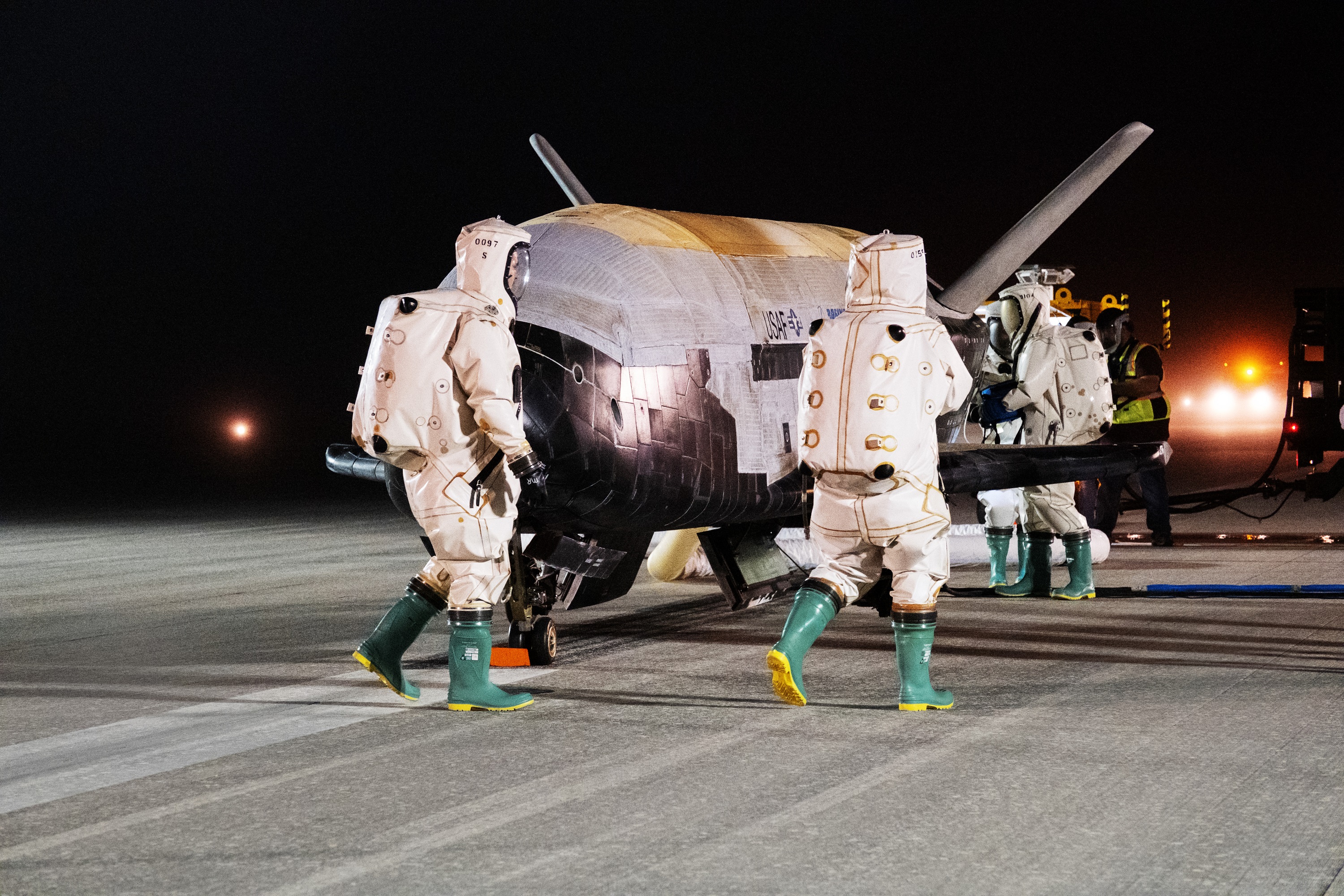US military's X-37B space plane lands, ending record-breaking mystery mission

The record-breaking sixth mission of the U.S. military's X-37B space plane is finally over.
The robotic X-37B touched down at NASA's Kennedy Space Center (KSC) in Florida today (Nov. 12) at 5:22 a.m. EST (1022 GMT). The winged vehicle had spent 908 days in orbit — more than four months longer than any previous X-37B flight.
The Boeing-built space plane also carried a service module on the newly completed mission, a first for the U.S. Space Force's X-37B program.
"With the service module added, this was the most we've ever carried to orbit on the X-37B, and we're proud to have been able to prove out this new and flexible capability for the government and its industry partners," Jim Chilton, senior vice president at Boeing Space and Launch, said in a statement today.
Related: The US Space Force's secretive X-37B space plane: 10 surprising facts

The X-37B resembles NASA's now-retired space shuttle but is much smaller, measuring just 29 feet (8.8 meters) from nose to tail. The space shuttle was 122 feet (37 m) long and was piloted — another key difference, as the X-37B is autonomous.
The U.S. Space Force is thought to own two X-37B vehicles, both of which were provided by Boeing. To date, the duo has flown six orbital missions, each of which is known by the signifier OTV ("Orbital Test Vehicle"):
Breaking space news, the latest updates on rocket launches, skywatching events and more!
- OTV-1: Launched on April 22, 2010 and landed on Dec. 3, 2010 (duration 224 days).
- OTV-2: March 5, 2011 to June 16, 2012 (468 days).
- OTV-3: Dec. 11, 2012 to Oct. 17, 2014 (674 days).
- OTV-4: May 20, 2015 to May 7, 2015 (718 days).
- OTV-5: Sept. 7, 2017 to Oct. 27, 2019 (780 days).
- OTV-6: May 17, 2020 to Nov. 12, 2022 (908 days).
Space Force and Boeing describe the X-37B as chiefly a testing platform; the vehicle allows researchers to see how payloads work in the space environment and then examine them afterward on the ground.
"Since the X-37B's first launch in 2010, it has shattered records and provided our nation with an unrivaled capability to rapidly test and integrate new space technologies," Chilton said.
Many of these payloads are classified, as are most of the X-37B's activities; the Space Force doesn't announce details of the vehicle's orbit, for example, or tell us in advance when each OTV mission is going to end.
But military officials do reveal information about some of the hardware the X-37B totes aloft. For example, we know that OTV-6 tested the U.S. Naval Research Laboratory's Photovoltaic Radio-frequency Antenna Module. This device, about the size of a pizza box, is designed to convert solar energy into microwaves, which can then be beamed down to Earth. Its work could help bring space-based solar power closer to reality, experiment team members have said.
OTV-6 also carried FalconSat-8, a satellite designed by cadets at the U.S. Air Force Academy that carries five experimental payloads of its own. The X-37B deployed FalconSat-8 in October 2021, and the satellite remains in orbit today, Boeing representatives said in today's statement.
OTV-6 carried a few known NASA experiments as well. One tested how space radiation affects plant seeds, and another gauged how various materials respond to the space environment.
"This mission highlights the Space Force's focus on collaboration in space exploration and expanding low-cost access to space for our partners, within and outside of the Department of the Air Force," Gen. Chance Saltzman, the Space Force's chief of space operations, said in the same statement. (The Space Force is part of the U.S. Air Force, much as the Marine Corps is part of the Navy.)
While OTV-6 set a new mission-duration record for the X-37B program, it didn't come close to the overall spaceflight mark.
Some Earth-observation and communications satellites operate in Earth orbit for a decade or more, for example. The International Space Station has been continuously occupied by rotating astronaut crews since November 2000, and NASA's Voyager 1 and Voyager 2 probes remain operational in interstellar space more than 45 years after lifting off.
Mike Wall is the author of "Out There" (Grand Central Publishing, 2018; illustrated by Karl Tate), a book about the search for alien life. Follow him on Twitter @michaeldwall. Follow us on Twitter @Spacedotcom or on Facebook.

Michael Wall is a Senior Space Writer with Space.com and joined the team in 2010. He primarily covers exoplanets, spaceflight and military space, but has been known to dabble in the space art beat. His book about the search for alien life, "Out There," was published on Nov. 13, 2018. Before becoming a science writer, Michael worked as a herpetologist and wildlife biologist. He has a Ph.D. in evolutionary biology from the University of Sydney, Australia, a bachelor's degree from the University of Arizona, and a graduate certificate in science writing from the University of California, Santa Cruz. To find out what his latest project is, you can follow Michael on Twitter.
